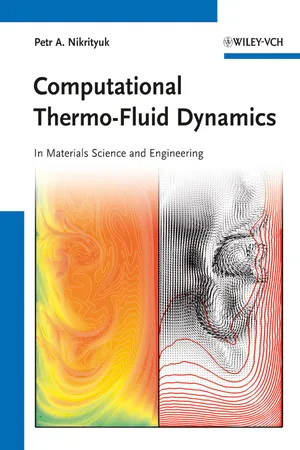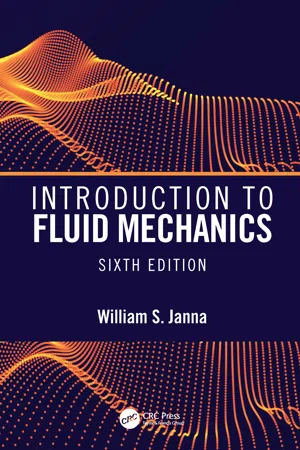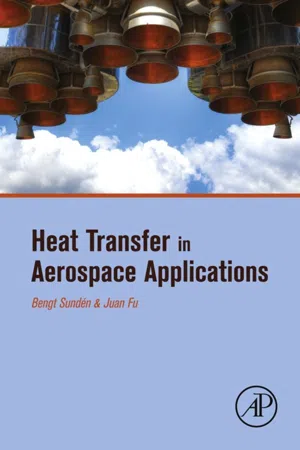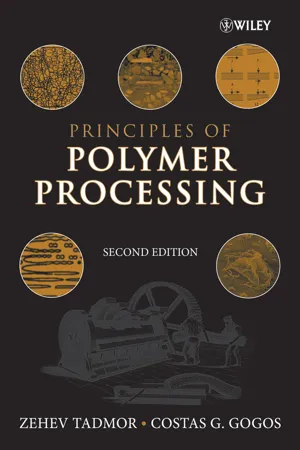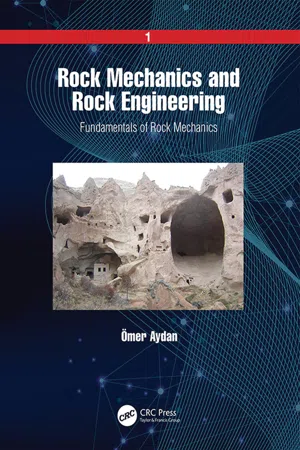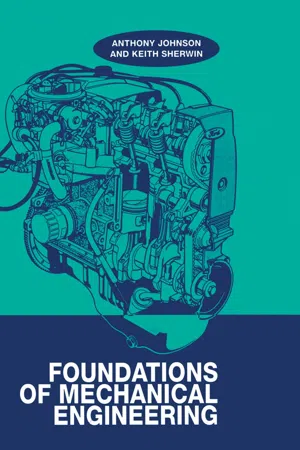Continuity Equation
The continuity equation in fluid dynamics states that the mass flow rate of a fluid is constant within a closed system, meaning that the amount of fluid entering a section of a pipe or channel must equal the amount leaving it. This principle is based on the conservation of mass and is a fundamental concept in fluid mechanics and engineering.
6 Key excerpts on "Continuity Equation"
- eBook - ePub
Computational Thermo-Fluid Dynamics
In Materials Science and Engineering
- Petr A. Nikrityuk(Author)
- 2011(Publication Date)
- Wiley-VCH(Publisher)
...Chapter 2 Mathematical Description of Physical Phenomena in Thermofluid Dynamics “Modeling is an evolutionary movement. Usually, there is a long path from the very first model to a more elaborate version.” Mario L. de Souza-Santos [6] The basis of almost all processes involving materials production is defined by melt flow and heat and mass transfers, which are coupled through phase transformations. Thus, to be able to understand and to predict the behavior of different materials adequately, we need to operate mathematical descriptions of these processes. In this chapter, the governing equations of conservation of mass, of momentum, of energy, and of solute will be reviewed. The basic conservation principles will only be briefly summarized here; a more detailed description can be found in the references [8, 10, 11, 13, 21]. For a convenient discussion in subsequent chapters, various forms of the governing equations used in this monograph will also be described. In addition to this, the standard boundary and initial conditions required for the solution of conservation equations are given in this chapter. 2.1 Conservation Equations for Continuum Media Conservation laws describe the physical principles governing the behavior of complex phenomena on macro- and microscale levels occurring in the science and technology of materials. At the macroscale level, conservation equations allow for the modeling of industrial processes occurring on the scale of an order higher than 10 −3 m. For example, applied to macroscale industrial casting elements these include such phenomena as macrosegregation, cracks, and shrinkage. On the microscale level, which is of the order 10 −4 –10 −6 m, the conservation equations can be used to describe the complex morphology of the microstructure (dendrite size, eutectic fraction, interdendritic arm spacing). Basically, there is no distinguishing between these two scales concerning the form of conservation equations...
- eBook - ePub
- William S. Janna(Author)
- 2020(Publication Date)
- CRC Press(Publisher)
...various quantities associated with a system of particles. In words, Equation 3.4 says instantaneous time rate of change in N for a system of particles = instantaneous time rate of accumulation of N within the control volume + amount of N leaving the control volume minus the amount of N entering 3.3 Continuity Equation The Continuity Equation is a statement of conservation of mass. In Equation 3.4, the flow quantity N becomes m, and n = m / m = 1. Equation 3.4 becomes d m d t S = ∂ m ∂ t CV + ∬ CS ρ V n d A For a system of particles, mass is constant, because it can be neither created nor destroyed. Thus, ∂ m ∂ t CV + ∬ CS ρ V n d A = 0 (3.5) In other words, the mass entering the control volume equals mass stored plus mass leaving. For steady flow with no storage, the mass entering equals mass leaving. For steady flow, Equation 3.5 becomes ∬ CS ρ V n d A = 0 (3.6) For incompressible fluids (liquids), ρ is a constant, and we obtain the following for steady incompressible flow: ∬ CS V n d A = 0 (3.7) This equation states that the volume of fluid entering the control volume per unit time equals the amount leaving. Equation 3.7 also states that a velocity distribution normal to the control surface must be integrated over the cross-sectional area at exits and inlets to the control volume. For many flow situations, however, a velocity distribution may not be known or derivable; in such cases, it is more convenient to use an average velocity at a cross section that is independent of area. (This assumes that we have one-dimensional flow or at least flow that can be treated as one-dimensional.) Thus, by definition, ∬ V n d A = V ∬ d A = V A or V = ∬ V n d A A (3.8) in which V is the average velocity. The product AV = Q is known as the volume flow rate with dimensions of L 3 / T (m 3 /s or ft 3 /s). Also used in fluid mechanics is the term m ˙, defined as the mass flow rate, where m ˙ = ρ Q = ρ A V...
- eBook - ePub
- Bengt Sundén, Juan Fu(Authors)
- 2016(Publication Date)
- Academic Press(Publisher)
...Appendix 1 Governing Equations for Momentum, Mass, and Energy Transport Abstract This appendix presents the governing equations for mass, momentum, and energy transport. Boundary layer versions of the equations are formulated and finally dimensional analysis and similarity rules are presented. Keywords Boundary layer; Energy equation; Mass conservation equation; The Navier–Stokes equations; Similarity A1.1. Continuity Equation (Mass Conservation Equation) The Continuity Equation (K.E.) expresses that mass is constant, or not destroyable. If one considers a mass balance for the volume element in Fig. A1.1, the following equation appears where ρ is the density of the fluid and u, v, and w are the velocity components in the x-, y-, and z-directions, respectively. ∂ ρ ∂ τ + ∂ (ρu) ∂ x + ∂ (ρv) ∂ y + ∂ (ρw) ∂ z = 0 (A1.1) Especially for steady-state (∂/∂τ ≡ 0) incompressible flow (ρ = constant) and two-dimensional (w ≡ 0, ∂/∂z ≡ 0) flow, one has ∂ u ∂ x + ∂ v ∂ y = 0 (A1.2) The derivation of Eqs. (A1.1) and (A1.2) can be found in, e.g., the book by Sunden [1]. According to Eq. (A1.1), the sum of the mass within the volume element dxdydz in Fig. A1.1 and the net in- or outflowing mass is constant. This mass can therefore be considered as a system from a thermodynamics point of view. Figure A1.1 Volume element dxdydz. A1.2. The Navier–Stokes Equations The equations of motion are derived from Newton's second law, which says that mass times acceleration in a certain direction is equal to the net external forces acting in the same direction. The external forces acting on a fluid element are split up into surface forces and volume or body forces. The volume or body forces act uniformly over the fluid element and are commonly generated by the gravity acceleration and electric or magnetic fields. The surface forces act as normal forces or shear forces on the boundary surface of the fluid element...
- eBook - ePub
- Zehev Tadmor, Costas G. Gogos(Authors)
- 2013(Publication Date)
- Wiley-Interscience(Publisher)
...Chapter 2 The Balance Equations and Newtonian Fluid Dynamics 2.1 Introduction 2.2 The Balance Equations 2.3 Reynolds Transport Theorem 2.4 The Macroscopic Mass Balance and the Equation of Continuity 2.5 The Macroscopic Linear Momentum Balance and the Equation of Motion 2.6 The Stress Tensor 2.7 The Rate of Strain Tensor 2.8 Newtonian Fluids 2.9 The Macroscopic Energy Balance and the Bernoulli and Thermal Energy Equations 2.10 Mass Transport in Binary Mixtures and the Diffusion Equation 2.11 Mathematical Modeling, Common Boundary Conditions, Common Simplifying Assumptions and the Lubrication Approximation 2.1 INTRODUCTION The engineering science of “transport phenomena” as formulated by Bird, Stewart, and Lightfoot (1) deals with the transfer of momentum, energy, and mass, and provides the tools for solving problems involving fluid flow, heat transfer, and diffusion. It is founded on the great principles of conservation of mass, momentum (Newton’s second law), and energy (the first law of thermodynamics). 1 These conservation principles can be expressed in mathematical equations in either macroscopic form or microscopic form. In this chapter, we derive these equations in some detail using the generalized, coordinate-free formulation of the Reynolds Transport Theorem (2). We believe that it isimportant for every student or reader to work through these derivations at least once...
- eBook - ePub
Rock Mechanics and Rock Engineering
Volume 1: Fundamentals of Rock Mechanics
- Ömer Aydan(Author)
- 2019(Publication Date)
- CRC Press(Publisher)
...Chapter 4 Fundamental governing equations Various actual applications of rock mechanics involve mass transportation phenomena such as seepage, diffusion, static and dynamic stability assessment of structures, and heat flow. Principles of fundamental laws presented herein follow basically the laws of continuum mechanics (e.g. Eringen, 1980; Mase, 1970). In this section, the fundamental governing equation of each phenomenon is presented. The governing equations are developed for the one-dimensional case, and they are extended to multidimensional situations. 4.1 Fundamental governing equations for one-dimensional case 4.1.1 Mass conservation law Mass conservation law is stated as: gained mass = input flux − output flux + mass generated Let us consider an infinitely small cubic element as shown in Figure 4.1. The preceding statement can be written in the following form for x -direction as: Δ m = q x Δ y Δ z Δ t − q x + Δ x Δ y Δ z Δ t + g Δ x Δ y Δ z Δ t (4.1) where m is mass, q is flux, and g is mass generated per unit volume per unit time. Figure 4.1 Illustration of mass-conservation law Terms Δ m and q are explicitly written as: Δ m = Δ ρ Δ x Δ y Δ z (4.2) q = ρ v (4.3) where ρ is density. and v is velocity. The quantity q x + Δ x can be written in the following form using the Taylor expansion: q x + Δ x = q x + ∂ q ∂ x Δ x + 0 2 (4.4) Inserting this relation in Equation (4.1) and dividing both sides by Δ x Δ y Δ z Δ t yields the following: Δ ρ Δ t = − Δ (ρ v) Δ x + g (4.5) Taking the limit results in mass conservation law for 1-D case as: ∂ ρ ∂ t = − ∂ (ρ v) ∂ x + g (4.6) 4.1.2 Momentum conservation. law Figure 4.2 Illustration of momentum-conservation law Momentum balance for a 1-D case can be written for a typical infinitely small control volume (simple momentum concept: p = m · v) (Fig...
- eBook - ePub
- A. D. Johnson(Author)
- 2017(Publication Date)
- CRC Press(Publisher)
...Steady flow of fluids 13 13.1 Aims To introduce the Continuity Equation for steady flow through an open thermofluid system. To introduce the momentum equation for steady flow. To introduce the steady flow energy equation and discuss its application to: boilers and condensers; turbines and compressors; nozzles. To introduce Bernoulli’s equation for ideal incompressible flow. To analyse velocity-measuring devices using Bernoulli’s equation. 13.2 Open Thermofluid System An open thermofluid system has already been introduced in section 1.4.2 as a region into, and out of, which there is a flow of fluid across the boundary defining the system. The basic features of an open thermofluid system are shown in Figure 13.1. It consists of a region in space that is defined by means of the boundary. Across the boundary there will be a flow of fluid and, in addition, there can be transfer of energy in the form of heat and work. The same sign convention is used as for the closed thermofluid system, described in section 11.6, with: heat input to an open system being positive; work output from an open system being positive. Just as for the closed system, the boundary of an open thermofluid system plays an essential part in defining the system. It provides a boundary between the fluid within this system and the surroundings. This can sometimes take the form of a physical boundary, as in the case of a steam boiler, where the boiler shell forms a solid boundary between the hot water/steam inside and the surrounding atmospheric air. The boundary also provides a necessary visual model for problem solving by defining the geometry of the particular region under consideration. By defining the boundary, the open thermofluid system is defined. Fig. 13.1 Open thermofluid system. Fig. 13.2 Steam plant. This can be visualized by considering the steam plant shown in Figure 13.2. It is similar to the steam plant shown in Figure 11.23 and consists of a boiler, turbine, condenser and feed pump...
